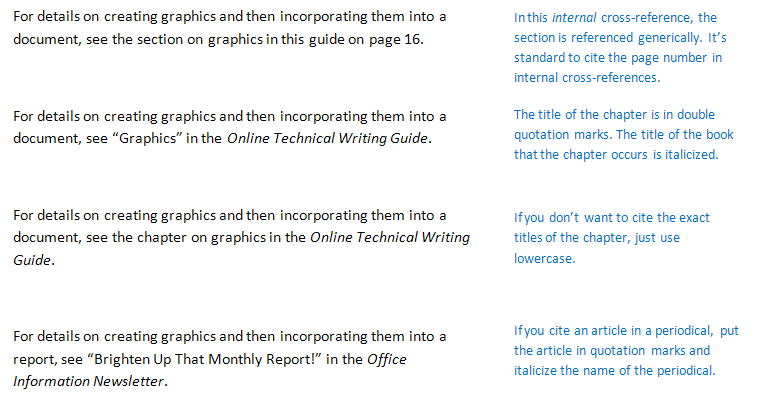Technical reports and instructions often require cross-references—those pointers to other places in the same document or to other information sources where related information can be found.
A cross-reference can help readers in a number of different ways:
- It can point them toward more basic information if, for example, they have entered into a document over their heads.
- It can point them to more advanced information if, for example, they already know the stuff you're trying to tell them.
- Also, it can point them to related information.
Related information is the hardest area to explain because ultimately everything is related to everything else—there could be no end to the cross-references. But here's an example from DOS—that troll that lurks inside PC-type computers and supposedly helps you. There are several ways you can copy files: the COPY command, the DISKCOPY command, and XCOPY command. Each method offers different advantages. If you were writing about the COPY command, you'd want cross-references to these other two so that readers could do a bit of shopping around.
Of course, the preceding discussion assumes cross-references within the same document. If there is just too much background to cover in your document, you can cross-reference some external website, book, or article that does provide that background. That way, you are off the hook for having to explain it all!
Components of Cross-References
Cross-references can be internal (within the same document) or external (outside of the current document). Most cross-refencing guidelines depend on whether the cross-reference is internal or external. With external sources, you cannot control the titles of books, chapters, headings, page numbers. They are likely to change!
With cross-references to external documents:
- Do not cite titles of books, chapters, headings exactly word-for-word verbatim. Instead, refer to the general topic covered.
- Do not cite exact chapter or section numbers or exact page numbers.
Now, a decent cross-reference consists of several elements:
- Name of the source being referenced—This can either be the title or a general subject reference. If it is a chapter title or a heading, put it in quotation marks; if it is the name of a book, magazine, report, or reference work, put it in italics. (Individual article titles also go in quotation marks.)
- Page number—Required if it is in the same document. If the cross-reference is to the beginning of a chapter and the chapter number and title are cited (either internal or external), no need for the page number. Readers can use the table of contents. If the cross-reference includes a heading internal to a numbered chapter, include the page number where that heading occurs.
- Subject matter of the cross-reference—Often, you need to state what's in the cross-referenced material and indicate why the reader should go to the trouble of checking it out. This may necessitate indicating the subject matter of the cross-referenced material or stating explicitly how it is related to the current discussion.
These guidelines are shown in the following illustration. Notice in that illustration how different the rules are when the cross-reference is "internal" (that is, to some other part of the same document) compared to when it is "external" (to information outside of the document).
Examples of Cross-References
Internal cross-references are cross-references to other areas within your same document; external ones are those to information resources external to your document.

Explanatory Phrasing in Cross-References
It is unhelpful and annoying to encounter cross-references like this: (see Fig. 3)
Readers need to know what the cross-reference material is about, why they should go look at it.
They also need just a brief idea of how to understand the internal cross-referenced text, images, table, chart, or diagram—just a hint. Here's an example (a gray background has been added to the cross-reference text):
 Figure 3. Percentage of global lithium reserves by type [6].
Figure 3. Percentage of global lithium reserves by type [6].

Figure 5. Lithium evaporation ponds [10].
Here's another example; the gray background is not in the original:

Figure 4. Open pit lithium mine [7].
Summary of Cross-Reference Rules
- If your cross-reference contains the title of a book, periodical, or report, italicize that title.
- If your cross-reference contains the title of an article or the title of a chapter or heading, enclose that title in quotation marks.
- If your cross-reference contains the title of a figure or table, enclose that title in quotation marks.
- If your cross-reference contains a brief indication of the contents of a chapter, use lowercase; do not use italics or quotation marks—the minimum requirement for a useful cross-reference.
- If your cross-reference contains a reference to a specific page elsewhere in the same document, include the page number unless that page is the beginning of a chapter (in which case just cite the chapter number).
- If you cross-reference some other document, include the page number only if you cite the document specifics (publication date or edition number) in a footnote or bibliography.
- If your cross-reference contains a reference to a chapter in the same document, include the chapter number and a brief indication of the contents of that chapter rather than quoting the title.
- If your cross-reference contains a reference to a chapter in some other document, do not include the chapter number but but do include a brief indication of the contents of that chapter rather than quoting the title.
I would appreciate your thoughts, reactions, criticism regarding this chapter: your response.
